St Paul's School, London
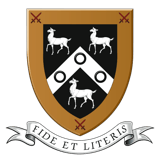 | |
| Motto |
Latin: Fide Et Literis (By Faith and By Learning) |
|---|---|
| Established | 1509 |
| Type | Independent school (Secondary) |
| Religion | Christian |
| High Master | Professor Mark Bailey |
| Chairman of the Governors | Johnny Robertson BSc |
| Founder | John Colet |
| Location |
Lonsdale Road Barnes London SW13 9JT United Kingdom Coordinates: 51°29′15″N 0°14′18″W / 51.4874°N 0.2383°W |
| DfE URN | 102942 Tables |
| Staff | c. 110 |
| Students | c.950 |
| Gender | Boys |
| Ages | 13–19 |
| Houses | A – H (known as clubs) |
| Former pupils | Old Paulines |
| Boat Club |
St Paul's School Boat Club |
| Website |
www |
St Paul's School is a boys' independent school, founded in 1509 by John Colet and located on a 43-acre (180,000m2) site by the River Thames, in Barnes, London. It is one of the original nine British public schools, the so-called 'Clarendon Schools' investigated by the Clarendon Commission set up in 1861 – however it was argued successfully that the school should be omitted from the Public Schools Act 1868.[1] Since 1881, St Paul's has had its own preparatory school, St Paul's Juniors (formerly Colet Court), which since 1968 has been located on the same site. According to its position in the national tables of GCSE and A level performance, St Paul's is considered one of the leading schools in the country.[2] The school is currently being rebuilt and expanded. The work is scheduled to be completed in phases over the next thirty years.
History
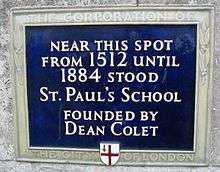
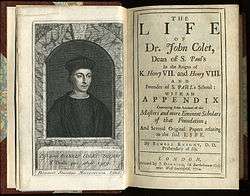
St Paul's School originally takes its name from St Paul's Cathedral in London. A cathedral school had existed since around 1103. By the 16th century however, it had declined, and in 1509, a new school was founded by John Colet, Dean of St Paul's Cathedral, on a plot of land to the north of the Cathedral.

The eldest son of Sir Henry Colet, a member of the Mercers' Company and twice Lord Mayor of the City of London, he inherited a substantial fortune and used a great part of it for the endowment of his school, having no family of his own; his 21 siblings all died in childhood and he was a celibate priest. He described himself in the statutes of the school as "desyring nothing more thanne Educacion and bringing upp chyldren in good Maners and litterature."[3]
Originally, the school provided education for 153 children of "all nacions and countries indifferently", primarily in literature and etiquette. The number 153 has long been associated with the miraculous draught of fishes recorded in St John's Gospel, and for several generations Foundation Scholars have been given the option of wearing an emblem of a silver fish. St Paul's was the largest school in England at its foundation, and its High Master had a salary of 13 shillings and sixpence weekly, which was double that of the contemporary Head Master of Eton College. The scholars were not required to make any payment, although they were required to be literate and had to pay for their own wax candles, which at that time were an expensive commodity.
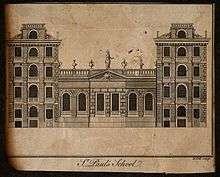
Colet was an outspoken critic of the powerful and worldly Church of his day, a friend of Erasmus and Sir Thomas More. Erasmus wrote textbooks for the school and St Paul's was the first English school to teach Greek, reflecting the humanist interests of the founder. Colet distrusted the Church as a managing body for his school, declaring that he "found the least corruption" in married laymen.[4] For this reason, Colet assigned the management of the School and its revenues to the Mercers' Company, the premier livery company in the City of London, with which his father had been associated. In 1876 the company were legally established as trustees of the Colet estate and the management of the school was assigned to a Board of Governors consisting of the Master, Wardens and nine members of the company, together with three representatives each of the Universities of Oxford, Cambridge and London. The Mercers' Company still forms the major part of the School's governing body, and it continues to administer Colet's trust.
One of St Paul's early headmasters was Richard Mulcaster, famous for writing two influential treatises on education (Positions, in 1581,[5] and Elementarie in 1582). His description in Positions of "footeball" as a refereed team sport is the earliest reference to organised modern football. For this description and his enthusiasm for the sport he is considered the father of modern football.[6]
Between 1861 and 1864, the Clarendon Commission (a Royal Commission) investigated the public school system in England and its report formed the basis of the Public Schools Act 1868. St Paul's was one of only nine schools considered by the Clarendon Commission, and one of only two schools which was not predominantly attended by boarders (the other day school was Merchant Taylors').
According to Charles Dickens, Jr., writing in 1879[7]
St Paul’s School (founded 1512 by John Colet, DD, Dean of St Paul’s), St Paul’s-churchyard — There are 153 scholars on the foundation, who are entitled to entire exemption from school fees. Vacancies are filled up at the commencement of each term according to the results of a competitive examination. Candidates must be between 12 and 14 years of age. Capitation scholars pay £20 a year. The governors of this school are appointed by the Mercers' Company and the Universities of Oxford, Cambridge, and London. The school exhibitions are determined as to number and value by the governors from time to time, and the school prizes are of considerable importance. The following are the university exhibitions. To the University of Cambridge there are the following exhibitions: Five exhibitions at Trinity, founded by Mr Perry in 1696, of the value of £10 a year; two exhibitions at St John’s, founded by Dr Gower in 1711, of the value of £10 a year, for the sons of clergymen. An exhibition, founded by Mr Stock in 1780 at Corpus Christi, of the yearly value of £30, given to a scholar recommended by the high master. Four exhibitions, in the same college, value £10 a year each, founded by Mr George Sykes in 1766, consolidated now in one exhibition, value £36 a year.
By comparison, in 2016 the Daily Telegraph reported that families earning up to £120k were being offered bursaries after the headmaster declared that the school had become "unaffordable."[8]
Between 1886 and 1895, St Paul's boys won 173 entrance awards at Oxford and Cambridge, which was 26 more than any other school. Over many years its record of Open Awards at Oxford and Cambridge in all subjects has been equal, or superior, to that of any other school of comparable size.
School coat of arms
Like many ancient educational foundations, St Paul's School traditionally used the arms of its founder, John Colet. His arms were Sable on a chevron Argent between three Hinds trippant Argent three Annulets Sable, and they were originally used by his great-grandfather, Richard Colet. As Dean of St Paul's, he was entitled to impale them with the arms of the Deanery, and the school has often used them in this form also. In 2002, the school obtained its own grant of arms from the College of Arms consisting of the arms of Dean Colet surrounded by a gold bordure, upon which the crossed swords of the Dean of St Paul's are repeated.
Apposition
Apposition is a traditional ceremony at St Paul's and was originally a way of allowing the Mercers Company to assess teaching staff and the High Master, with the option of dismissing or reappointing them. The assessment takes the form of a third-party 'apposer', often a leading academic, judging the quality of teaching through scrutinising lectures given by boys in their final year. Today it is primarily a prize giving event, where prizes are awarded to senior boys who have excelled in particular subjects. The Apposition Dinner is held in the Mercer's Hall in London every year around May.
Consequences of apposition have led to the dismissal of previous High Masters including Thomas Freeman, for lack of learning (although more probably for holding the incorrect religious views) in 1559. In 1748, High Master Charles was removed as he had allegedly threatened to "pull the Surmaster by the nose and kick him about the school."
Since it was re-introduced in 1969,[9] the ceremony today takes place in May and is purely ceremonial, incorporating prize giving for boys in the final two years of the school.
Buildings
The original school, which stood in St Paul's Churchyard, was destroyed with the Cathedral in the Great Fire of London in 1666.[10] The school was twice rebuilt, first in 1670, and again in Cheapside in 1822; but towards the end of the 19th century, as London expanded and residents moved away from the City of London and its environs, it was decided that the school should move to larger premises.
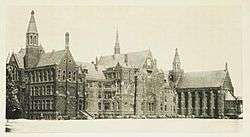
In 1884 a new building designed by the architect Alfred Waterhouse rose to dominate the countryside of Hammersmith. The terracotta for the Hammersmith school was made by the famous Gibbs and Canning Limited of Tamworth. At this time the street numbering was changed locally and so the school address, whether by accident or design, became 153 Hammersmith Road.[11] The preparatory school, Colet Court, was soon afterwards housed in new premises in a similar style on the opposite side of the road.
In September 1939 the school was evacuated to Easthampstead Park, near Crowthorne in Berkshire, where, under the then High Master, W. F. Oakeshott, it became solely a boarding school for the period of the war. Playing fields and some other facilities were borrowed from nearby Wellington College, but the boys and the teachers from the two schools remained entirely separate.
In the meantime, the London buildings became the headquarters of the Home Forces in July 1940[12] and the headquarters of the XXI Army Group under the command of General, later Field-Marshal, Bernard Montgomery, himself an Old Pauline, in July 1943. There the XXI army part of the military side of the invasion of Europe was planned, including the D-Day landings.[13] The map that he used is still present in the modern day site of the school in the Montgomery Room. The school recovered its buildings in September 1945, and resumed life essentially as a day school, although it retains a small number of boarders to this day.
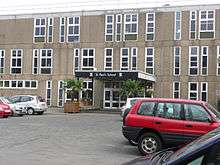
By 1961 it had become evident that the old school buildings were unsuited to modern educational needs. By good fortune, the opportunity then came to rebuild the School on a 45-acre (182,000 m²) riverside site at Barnes, adjacent to Hammersmith Bridge. This land had previously been the site of reservoirs which were filled in, reputedly with earth excavated during the construction of the Victoria line. The sports pitches took a long time to settle, and competitive matches were not played regularly at the Barnes site until summer 1979.
The present and fifth School buildings were opened in September 1968, to designs by architects Philip Powell and Hidalgo Moya. The new site also includes the preparatory school, St Paul's Juniors (formerly Colet Court), whose pupils account for roughly one half of the senior school's intake each year. The Waterhouse building on Hammersmith Road was demolished amid protests to allow building of flats, apart from the gates and the peripheral walls, the High Master's House, and a toolhut, though the Colet Court building also survives.
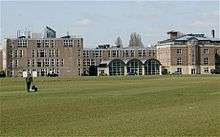
The 1968 buildings include a 25m, 6 lane swimming pool and dining hall shared with St Paul's Juniors. Extensive sports facilities notably include a fencing salle, six rugby fives courts, three squash courts and a Racquets court. The location next to the River Thames meant that a rowing boathouse was included in the plans, which itself included both an indoor training tank and housing to accommodate a boatman, whose primary job was to build and maintain the boats. A striking and deliberate omission from the new buildings was any provision for a school hall capable of holding all masters and boys simultaneously, and although the main sports hall is large enough to accommodate the entire school, the difficulty in setting up enough chairs means that the hall is used to house the entire school only twice per year. There were originally two boarding houses in the 1968 buildings (School House and High House) accommodating up to 120 boarders, but the number of boarders has steadily declined since then and is now only 20. One of the boarding houses (School House) has been demolished to make way for a new music building, which houses the Wathen Hall. The other (High House, renamed School House) is in the process of being demolished, with boarders relocated to the recently renovated Colet House. The only building which remained from the previous Water Board landowners became the music department for St Paul's Juniors.
The original buildings were built using a modular system of interlocking concrete slabs, known as the CLASP system. This allowed for relatively quick and cheap construction, and allowed for the fact that much of the site was formed from reservoir land which was still settling. The whole complex is now in need of replacement; the only existing buildings likely to remain are the Music school, incorporating the Wathen Hall from 1999 and the Rackets Court.
2009-Present day
The boys' school numbered 856 boys in 2009, the 500th year of its foundation. An ambitious total rebuilding of the school at its present site is planned, to be completed over a 25-year period. While former High Master, George Martin Stephen, announced an aspiration for the school to be needs-blind within 25 years – £250 million will need to be raised to accomplish this.
The school day lasts from 8.35 a.m. to 4.15 p.m. and consists of 8 periods, including a one-and-three-quarter-hour lunch break during which pupils are encouraged to participate in sporting or extracurricular activities such as music, debating or computing. Pupils of all ages are not allowed to leave the school premises without permission at any time during the day.
The school still maintains a boarding house. There are strong boarding house traditions including the annual bonfire and two hours of compulsory study known as "prep" every evening. Newer traditions include the sponsored all night five-a-side football tournament, a "charity sponging" event. However, the charity sponging did not take place in 2010 due to, as some boarders claim, complaints from a boarding student who had been "sponged" particularly often and the future of the traditional event is unclear.
The school has recently opened its state of the art Science wing. The wing is a four-storey building finished in February 2013, built to give university standard of work spaces and labs. It has a floor dedicated to each branch of science, e.g. biology, physics and chemistry. The bottom floor is a careers and university section to for the older students. Tables with computers and spaces for students or staff to use as desks are available on all floors.
A large number of music concerts, art exhibitions and plays take place each year, and pupils regularly receive national recognition for their achievements. The school also has a strong sports department; St Paul's was a founding member of the Rugby Football Union in 1871 and was pre-eminent in public school boxing, its first team failing to win only two boxing matches against first team boxers from other schools over a period of 25 years; however, boxing was discontinued as a school sport in the 1960s. More recently, the school teams were runners-up in the rugby U15 Daily Mail Cup in 2005 and in 2007. The Boat Club has won the Princess Elizabeth Challenge Cup at Henley Royal Regatta five times (most recently on 5 July 2015) and holds the current J15 2nd VIII record in the School's Head of the River (SHORR.)
The school has a strong record in rugby. In 1979, the 1st XV of St Paul's, nicknamed the 'Invincibles' went twelve matches undefeated.[14] Big rivals for the school are RGS Guildford, King's College School, Dulwich College, St John's Leatherhead, Merchant Taylors', Wellington and Eton.[14]
Sport facilities
The school has numerous sports facilities, and sport plays a major part in the everyday lives of the boys. There is a large sports hall, gymnasium, dojo, fencing salle, 25m swimming pool, 6 fives courts, a rackets court, three squash courts, a fitness centre, a 100m sprint straight, ten tennis courts and a multi use games area (MUGA). There is also a large boathouse, and extensive playing fields which consist of 11 football or rugby pitches during the winter months, or seven cricket pitches during the summer months.
Renewal campaign
The renewal campaign is the project to rebuild the entire school campus, frequently known as the Masterplan.
The majority of the current buildings date from the 1960s, and the CLASP technology used in the construction of the buildings has a limited lifespan. Even though over the last few years various buildings (such as the Wathen Hall Music School, Rackets Court and Milton Building) have been added on the campus wherever space was available, the dated buildings represent approximately three quarters of the school.[15]
Local planning restrictions combined with a lack of available surplus land mean that St Paul's is faced with progressively replacing obsolete buildings with new ones located in the same general area. The plan should eventually result in a large building footprint area increase as well as increasing the amount of staff housing. The number of car parking spaces will be reduced, but there will be much more available room for bicycles.
In 2007, Nicholas Hare Architects were appointed to produce detailed designs for the first set of new buildings.[16] Late in 2009, Richmond Council granted St Paul's detailed planning permission, and building started in 2011.[17] The new science block and courtyard building was completed in 2012 and won a Civic Trust Award in 2013 and a RIBA London Award in 2015. Two years later, the new Drama Centre and Samuel Pepys Theatre was completed. This building was also designed by Nicholas Hare Architects.
Examinations
In 2008, for the first time, its students sat the IGCSE exam instead of the GCSE in Science, following sitting IGCSE in Mathematics the previous year. The school does not currently offer the International Baccalaureate as an alternative to A Level, and has suffered on many league tables as a result. Dr Martin Stephen, former High Master of St Paul's, has stated he believes that "league tables put massive pressure on headmasters to do bad things"[18] and announced that St Paul's will be joining other private schools in London in withdrawing from the ISC's 2008 league tables.[19]
The school record for students gaining places at Oxford or Cambridge was 74 pupils in 2010.[20]
The school had its first student attain a place on the Prime Minister's Global Fellowship programme in 2009.[21]
The school also has its first student win the national competition of IFS Young Business Writer of the Year 2010 Award, an award for the top young business thinker.[22]
GCSE summary: last five years[23]
| YEAR | %A* | %A*A | %A*AB |
|---|---|---|---|
| 2016 | 77.8 | 96.7 | 99.9 |
| 2015 | 82.3 | 97.9 | 99.9 |
| 2014 | 84.3 | 97.6 | 99.7 |
| 2013 | 78.6 | 95.9 | 99.5 |
| 2012 | 82.5 | 97.6 | 98.8 |
A level summary: last five years[23]
| YEAR | %A* | %A*A | %A*AB |
|---|---|---|---|
| 2016 | 45.0 | 84.7 | 98.0 |
| 2015 | 42.1 | 81.4 | 96.7 |
| 2014 | 47.7 | 86.4 | 97.7 |
| 2013 | 44.9 | 86.0 | 96.0 |
| 2012 | 55.6 | 88.0 | 98.5 |
High Masters of St Paul's School
The Headmaster of St Paul's is known as the High Master and his deputy is known as the Surmaster, which is also the title given to him in the statutes. The following have been High Masters of St Paul's School:
| Name | Years as High Master |
|---|---|
| William Lily | 1509–1522 |
| John Ritwise | 1522–1532 |
| Richard Jones | 1532–1549 |
| Thomas Freeman | 1549–1559 |
| John Cook | 1559–1573 |
| William Malym | 1573–1581 |
| John Harrison | 1581–1596 |
| Richard Mulcaster | 1596–1608 |
| Alexander Gill Senior | 1608–1635 |
| Alexander Gill Junior | 1635–1640 |
| John Langley | 1640–1657 |
| Samuel Cromleholme | 1657–1672 |
| Thomas Gale | 1672–1697 |
| John Postlethwayt | 1697–1713 |
| Philip Ayscough | 1713–1721 |
| Benjamin Morland | 1721–1733 |
| Timothy Crumpe | 1733–1737 |
| George Charles | 1737–1748 |
| George Thicknesse | 1748–1769 |
| Richard Roberts | 1769–1814 |
| John Sleath | 1814–1837 |
| Herbert Kynaston | 1838–1876 |
| Frederick William Walker | 1877–1905 |
| Albert Ernest Hillard | 1905–1927 |
| John Bell | 1927–1938 |
| Walter Fraser Oakeshott | 1938–1946 |
| Robert Leoline James | 1946–1953 |
| Antony Newcombe Gilkes | 1953–1962 |
| Thomas Edward Brodie Howarth | 1962–1973 |
| James Warwick Hele | 1973–1986 |
| Peter Pilkington, later Lord Pilkington of Oxenford | 1986–1992 |
| Richard Stephen Baldock | 1992–2004 |
| George Martin Stephen | 2004–2010[24] |
| Mark Bailey | 2011–[25] |
Associated schools
By the end of the 19th century, the funds of the Dean Colet Foundation had increased to such an extent that the Trustees decided to build a school for girls, and in 1904, St Paul's Girls' School was opened in Brook Green, Hammersmith, just around the corner from the then site of the boys' school in Hammersmith Road. Unlike the boys', the girls' school remains in its original position, although it has expanded and constructed new buildings and facilities alongside the old. In 1881, a boys' preparatory school was founded which later became Colet Court, now St Paul's Juniors. St Paul's Juniors is now on the same site as the main school and most of its pupils are expected to pass into St Paul's School when they reach the age of 13. It thus serves as a junior school for the main establishment.
Former pupils
Former pupils are known as Old Paulines, and may keep in touch with each other through the Old Pauline Club.[26] Various sporting clubs are affiliated to the Old Pauline Club, such as the Old Pauline Football Club (OPFC), which is the oldest Old Boys' rugby club in the world, the Old Pauline Association Football Club (OPAFC), the Old Pauline Cricket Club (OPCC), Colet Boat Club, which regularly races in national events, the Old Pauline Association Club (OPAC) and the Old Pauline Harvey Chess Society (OPHCS), who have participated in many national tournaments with moderate success. The club is located on a 15-acre (61,000 m2) site in Thames Ditton and owns a number of sports pitches there, as well as the Colets' Health and Fitness Club.
See also
References
- ↑ An Act to make further Provision for the good Government and Extension of certain Public Schools in England, in: Great Britain (1868). AA collection of the public general statutes passed in the Thirty-first and Thirty-second year of the reign of Her Majesty the Queen Victoria. pp. 560–571. Retrieved 15 May 2011.
- ↑ "St Paul's School OFSTED Inspection Report, Educational Standards Achieved by Pupils at the School". October 2001. Retrieved 27 April 2008.
- ↑ "STATUTA PAULINÆ SCHOLÆ". Retrieved 27 April 2008.
- ↑ Coulton, George (1938). Medieval Panorama. Cambridge University Press. p. 659.
- ↑ "Positions wherein...". Archived from the original on 27 September 2006. Retrieved 27 April 2008.
- ↑ Francis, Azra (2013). Shakespeare's World. AuthorHouse. p. 255. ISBN 9781491819494.
- ↑ Charles Dickens, Jr., Dickens's Dictionary of London (1879)
- ↑ "St Paul's School offering bursaries for children of parents who earn £120k a year". Daily Telegraph. 17 September 2016. Retrieved 18 September 2016.
- ↑ Mead, A.H. (1990). A Miraculous Draught of Fishes: a history of St Paul's School, p.126. ISBN 0-907383-05-X.
- ↑ Jokinen, Anniina (26 October 2001). "The Great Fire of London, 1666". Luminarium. Retrieved 27 April 2008.
- ↑ 51°29′34″N 0°12′55″W / 51.49278°N 0.21528°W
- ↑ Newbold, p. 245
- ↑ Mead, Hugh (4 May 2006). "A brief history of the St Paul's School". Retrieved 27 April 2008.
- 1 2
- ↑ "Background - Masterplan". St Paul's School. Archived from the original on 2007-10-23.
- ↑ "Architect Announced". St Paul's School. Archived from the original on 2007-10-25. Retrieved 27 April 2008.
- ↑ "Renewal campaign - St Paul's School". St Paul's School. Retrieved 12 April 2011.
- ↑ "Tables 'restrict A-level choices'". BBC News. BBC News. 25 April 2008. Retrieved 27 April 2008.
- ↑ Henry, Julie (26 April 2008). "Top schools refuse to join exam tables". The Telegraph. London. Retrieved 27 April 2008.
- ↑
- ↑ British Council website "Fellows" accessed 10 November 2009.
- ↑ "Student Investor success | St Paul's School". Stpaulsschool.org.uk. 2010-03-25. Retrieved 2013-12-05.
- 1 2 "Exam results | St Paul's School". Retrieved 2013-12-05.
- ↑ Hohler, F C G (2010-06-29). "High Master to stand down in 2011". St Paul's School. Retrieved 2010-06-29.
- ↑ "Appointment of High Master". St Paul's School. 2010-10-11. Retrieved 2010-10-30.
- ↑ "Old Pauline Club - St Paul's School". stpaulsschool.org.uk.
Sources
- Newbold, David John. "British planning and preparations to resist invasion on land, September 1939 - September 1940". kclpure.kcl.ac.uk. King's College, University of London. Retrieved 1 August 2015.
External links
| Wikimedia Commons has media related to St Paul's School, London. |
- Official website
- A History of St Paul's School Sir Michael McDonnell's classic history of the school, scanned onto the internet (1909)
- Old Pauline Club